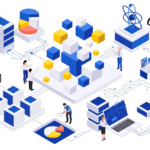
Behind every episode of Stranger Things lies an infrastructure capable of handling billions of requests daily. Here’s how it really works.
When you click “Play” on Netflix, you initiate a series of operations that span continents, data centers, and thousands of microservices. Netflix isn’t just a streaming platform; it’s a distributed engineering marvel serving over 270 million users across the globe.
But how does Netflix ensure that your episode of Bridgerton loads in seconds, whether you’re in Rome or Tokyo?
The Evolution: From Monolith to Microservices
The Great Refactoring
Netflix’s journey began with a monolithic application, but as the platform grew, it became clear that maintaining and scaling the monolith was impractical. With hundreds of developers simultaneously working on a single codebase, debugging and maintaining the system became increasingly chaotic.
The shift to microservices wasn’t just a technological upgrade; it was a survival necessity. Today, Netflix manages thousands of independent microservices, each handling a specific functionality within the ecosystem.
Why Java?
Netflix’s decision to use Java as its primary language was strategic:
Scalable Performance: Java’s JVM (Java Virtual Machine) enables optimal memory management and performance under heavy loads, crucial for handling Netflix’s global traffic.
Mature Ecosystem: Java offers a rich ecosystem of libraries and frameworks, allowing Netflix to leverage production-ready tools without reinventing the wheel.
Cross-Platform Flexibility: The JVM’s ability to run on various environments made it ideal for deployment across AWS and multiple global data centers.
Talent Availability: Java’s widespread use meant that Netflix could easily hire skilled developers, ensuring a steady flow of talent to fuel growth.
The Two-Faced Architecture
Netflix’s architecture is split into two distinct cloud systems that handle different operations:
Control Plane (AWS): The Brain
Everything you interact with before you press “Play”—browsing, searching, recommendations, and account management—is handled by Java microservices on AWS. This includes:
- Recommendation Engine: Machine learning (ML) algorithms analyzing your viewing preferences.
- User Management: Handling authentication, profiles, and preferences.
- Cataloging: Storing metadata about movies and TV shows.
- Billing and Subscriptions: Managing payments and subscriptions.
Data Plane: Content Distribution
Once you hit “Play,” Netflix’s proprietary CDN, Open Connect, takes over. Netflix is the only major streaming service to build its own content delivery network infrastructure, investing approximately $1B over the last decade in the Open Connect project.
Open Connect: The Magic Behind Streaming
The Problem to Solve
Sending 4K video across the globe is both costly and slow. To mitigate high costs and performance issues related to long-distance data transfers, Netflix built its own Content Delivery Network (CDN), Open Connect.
The Solution: OCA (Open Connect Appliances)
Netflix introduced Open Connect Appliances (OCAs), placing physical servers inside Internet Service Providers (ISPs) to cache popular content locally.
How OCAs work:
- Strategic Placement: Servers are positioned directly within ISPs to reduce latency and bandwidth costs.
- Intelligent Caching: ML algorithms predict content demand and pre-load content based on regional popularity.
- Overnight Distribution: Content is distributed during low-traffic hours, reducing strain on networks.
- Automatic Failover: If a server fails, traffic is instantly redirected to other available servers, ensuring no disruption in service.
The Impressive Numbers
- 17,000+ servers distributed worldwide
- 165+ countries served
- 95% of traffic delivered with less than 100ms latency
- Petabytes of data transferred daily
The Tools That Revolutionized Java
Netflix didn’t just use Java; it built groundbreaking tools that are now integral to the Java ecosystem.
Hystrix: The Circuit Breaker That Changed Everything
When a microservice fails, you don’t want it to take down the entire system. Hystrix introduced the circuit breaker pattern, ensuring that if a service fails, requests are rerouted, preventing cascading failures.
Practical Example: If the recommendation service crashes, the homepage will still function, showing generic content instead of crashing.
Eureka: The GPS for Microservices
In a microservices architecture, where services are loosely coupled, finding dependencies is crucial. Eureka solves this by enabling services to dynamically register themselves and discover other services.
- Each service registers with Eureka at startup.
- Other services query Eureka to find dependencies.
- Automatic load balancing across instances.
- Continuous health checks to remove failed instances.
RxJava: Reactive Programming
Netflix adopted reactive programming before it became mainstream. RxJava facilitates the elegant handling of asynchronous data streams, which is critical for real-time streaming.
javaCopia// Simplified example of how Netflix might handle
// streaming requests using RxJava
Observable<Video> videoStream =
userService.getCurrentUser()
.flatMap(user -> recommendationService.getRecommendations(user))
.flatMap(recommendations -> videoService.loadVideo(recommendations.get(0)))
.subscribeOn(Schedulers.io())
.observeOn(AndroidSchedulers.mainThread());
Resilience: Designing for Failure
Chaos Engineering
Netflix invented Chaos Monkey, a tool that randomly terminates servers in production to test the resilience of the system. This may sound reckless, but it has been crucial in building a fault-tolerant infrastructure.
Principles of Chaos Engineering:
- Assume everything will fail.
- Test failures in production environments.
- Automate recovery.
- Continuously monitor all systems for anomalies.
Resilience Patterns
- Circuit Breakers: Protect against slow or broken services.
- Bulkheads: Contain failures to prevent them from spreading.
- Intelligent Timeouts: Prevent long-running requests from blocking the system.
- Retry with Backoff: Automatically retry failed operations after a delay.
Database: The Persistence Challenge
With microservices, sharing a single database can lead to tight coupling. Netflix tackles this by using polyglot persistence, meaning different databases are used for different needs.
Polyglot Persistence
Netflix employs multiple databases, each chosen based on its specific use case:
- Cassandra: For highly scalable data, such as viewing history and user preferences.
- MySQL: For transactional data, like billing and account management.
- Elasticsearch: For fast search and analytics.
- Redis: For high-speed caching.
The Eventual Consistency Problem
With thousands of distributed databases, maintaining immediate consistency across all services is impossible. Netflix embraces eventual consistency, where data will eventually converge to a consistent state.
Practical Example: If you add a movie to your favorites, it might not appear on all devices immediately, but it will sync within seconds.
Observability: Seeing the Invisible
Metrics, Logs, Traces
Netflix generates petabytes of telemetry data daily, including:
- Metrics: CPU usage, memory consumption, latency, and error rates.
- Logs: Detailed records of events for debugging and troubleshooting.
- Distributed Tracing: Tracking a request’s journey through multiple microservices.
Real-Time Monitoring
Anomalies are detected and addressed in real time:
- Sudden latency spikes
- 5xx error peaks
- Performance degradation
- Regional network issues
Machine Learning: The AI Behind Recommendations
Personalized Algorithms
Netflix doesn’t use a single recommendation engine but relies on hundreds of specialized ML models:
- Collaborative Filtering: Suggests content based on what others like.
- Content-Based: Analyzes movie metadata (genre, actors, director).
- Deep Learning: Uses neural networks to detect complex patterns.
- Contextual Bandits: Optimizes recommendations in real-time.
A/B Testing at Scale
Netflix runs thousands of A/B tests simultaneously to continuously improve user experience and service performance:
- Testing different recommendation algorithms.
- Experimenting with UI designs.
- Evaluating video encoding strategies.
- Analyzing content positioning.
Video Encoding and Delivery
Adaptive Encoding
Each video is encoded into hundreds of variants, including various resolutions, bitrates, and codecs, to cater to different devices and network conditions.
Adaptive Streaming
The Netflix player adapts to available bandwidth in real-time:
- It adjusts video quality to minimize buffering.
- Preloads video segments for smoother playback.
- Handles connection interruptions gracefully.
Challenges and Lessons Learned
Global Latency
To minimize global latency, Netflix uses several strategies:
- Edge Caching: Popular content is cached closer to users.
- Predictive Caching: ML predicts what users are likely to watch next.
- Regional Failover: Traffic is redirected if a data center fails.
Bandwidth Costs
Netflix pays billions of dollars annually for bandwidth. Open Connect helps mitigate this by:
- Peering Agreements: Direct agreements with ISPs.
- Traffic Shaping: Distributing content during off-peak hours.
- Codec Efficiency: AV1 codec reduces data by 30% compared to H.264.
What We Can Learn
For Teams of Any Size
Even though Netflix operates at a massive scale, the following lessons are universally applicable:
- Start Simple, Scale Gradually: You don’t need to start with thousands of microservices.
- Monitor from Day One: Metrics, logs, and alerts are vital for managing complex systems.
- Design for Failure: Implement circuit breakers and retries even in small applications.
- Use the Right Database for the Job: Avoid using a one-size-fits-all approach.
- Automate Everything: From deployment to testing and monitoring.
Architectural Patterns
- API Gateway: A single entry point for all client requests.
- Event Sourcing: Store events instead of states for full auditing.
- CQRS: Separate reads and writes for optimal performance.
- Saga Pattern: Handle distributed transactions without global locks.
The Future: Where Netflix Is Heading
Edge Computing
Netflix is exploring edge computing to further reduce latency and improve personalization:
- Local Personalization: Running AI models on user devices.
- Dynamic Transcoding: Real-time video encoding.
- P2P Delivery: Users sharing content with each other.
Emerging Technologies
- WebAssembly: For improved browser performance.
- GraphQL: More efficient APIs, especially for mobile apps.
- Kubernetes: Large-scale container orchestration.
- Service Mesh: Advanced management of microservice communication.
Conclusion: Engineering as a Competitive Advantage
Netflix has proven that software architecture is not just a technical detail; it’s a strategic asset. The company’s investment in Open Connect and its engineering culture has allowed it to scale effortlessly and outperform competitors.
Next time you watch Netflix, remember the thousands of coordinated microservices, the massive data infrastructure, and the engineers working round the clock to deliver a seamless experience. Netflix hasn’t just transformed how we watch TV—it’s redefined what it means to build software at global scale.
Want to dive deeper? The Netflix Tech Blog is a treasure trove of technical case studies. And remember: every great architecture starts with a single commit.

